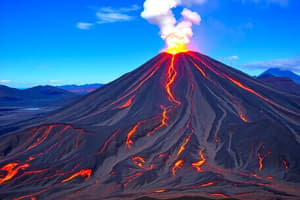Podcast
Questions and Answers
Which type of volcano is characterized by steep sides and a cone shape, formed by layers of lava and ash?
Which type of volcano is characterized by steep sides and a cone shape, formed by layers of lava and ash?
- Stratovolcano (correct)
- Shield volcano
- Cinder cone
- Caldera
What is the primary factor determining the type of volcanic eruption?
What is the primary factor determining the type of volcanic eruption?
- The age of the volcano
- The viscosity of the magma and the amount of dissolved gas (correct)
- The elevation of the volcano
- The size of the magma chamber
Which of the following is NOT a type of volcanic eruption?
Which of the following is NOT a type of volcanic eruption?
- Hawaiian
- Strombolian
- Vulcanian
- Tectonic (correct)
How does geothermal energy relate to volcanoes?
How does geothermal energy relate to volcanoes?
What is a significant hazard that can result from a volcanic eruption?
What is a significant hazard that can result from a volcanic eruption?
Which of the following is NOT a sign of an impending volcanic eruption?
Which of the following is NOT a sign of an impending volcanic eruption?
What is the primary reason for monitoring volcanoes?
What is the primary reason for monitoring volcanoes?
What is the significance of early warning systems in relation to volcanic eruptions?
What is the significance of early warning systems in relation to volcanic eruptions?
Flashcards
Volcano Classification
Volcano Classification
Volcanoes are classified by eruptive activity and shape.
Effusive Eruptions
Effusive Eruptions
Eruptions characterized by flowing lava.
Explosive Eruptions
Explosive Eruptions
Violent volcanic eruptions with significant energy.
Shield Volcanoes
Shield Volcanoes
Signup and view all the flashcards
Stratovolcanoes
Stratovolcanoes
Signup and view all the flashcards
Volcanic Hazards
Volcanic Hazards
Signup and view all the flashcards
Monitoring Volcanic Activity
Monitoring Volcanic Activity
Signup and view all the flashcards
Geothermal Energy
Geothermal Energy
Signup and view all the flashcards
Study Notes
Volcanoes: Classification and Impacts
- Volcanoes are classified based on their eruptive activity and shape, leading to various landforms.
- Types of volcanic eruptions include effusive (flowing lava) and explosive (violent eruptions).
- Different eruptive styles create diverse volcanic landforms like shield volcanoes, stratovolcanoes, cinder cones, and calderas.
- Shield volcanoes are broad, gently sloping structures built from fluid lava flows.
- Stratovolcanoes are steep-sided, cone-shaped volcanoes formed by layers of lava and ash.
- Cinder cones are small, steep-sided volcanoes composed of loose volcanic fragments.
- Calderas are large, basin-shaped depressions formed by the collapse of a volcano.
Volcanic Eruptions: Types and Energy
- Volcanic eruptions vary in intensity and explosivity, determined by magma viscosity and gas content.
- The type of eruption depends primarily on the magma's viscosity and the amount of dissolved gas.
- High-viscosity magma and high gas content lead to explosive eruptions, while low-viscosity magma and low gas content lead to effusive eruptions.
- Examples of eruption types include Hawaiian, Strombolian, Vulcanian, and Plinian, each with unique characteristics producing distinct volcanic landscapes.
Volcanic Energy and Societal Impact
- Volcanic eruptions release substantial geothermal energy, potentially usable for electricity generation.
- However, most geothermal energy production is costly.
- Volcanic eruptions can cause extensive damage to infrastructure, agriculture, and human lives.
- Long-term effects of eruptions can impact the environment and global climate.
- Ashfall, lahars (volcanic mudflows), and pyroclastic flows are significant eruption hazards.
- Early warning systems are crucial for reducing the societal impact of volcanic eruptions.
Predicting Volcanic Eruptions
- Scientists monitor volcanoes for signs of an impending eruption.
- Key monitoring indicators include ground deformation, increased seismic activity, variations in gas emissions, and unusual heat flow.
- Monitoring tools are essential for providing early warning systems.
- Accurate prediction can significantly reduce the impact on humans and livelihoods.
Studying That Suits You
Use AI to generate personalized quizzes and flashcards to suit your learning preferences.




